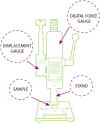3D printing of stents via two-photon polymerization
- PMID: 40596595
- PMCID: PMC12214932
- DOI: 10.1038/s41598-025-07190-4
3D printing of stents via two-photon polymerization
Abstract
Stents are medical devices used to treat the narrowing of the blood vessel, most commonly caused by atherosclerosis. Currently used bare-metal, drug-eluting stents are limited in size and architectural complexity, and there are a few risks associated with these medical devices. In some cases stents can cause thrombosis or even death. Furthermore, said risk increases while stenting relatively small vessels. This paper shows that vascular stents for relatively small vessels and/or for patient-specific stenting applications can be printed using two-photon polymerization (2PP). 2PP is an additive manufacturing technique with sub-μm resolution and unlimited 3D geometry potential. These capabilities were used to produce stents for small blood vessels, which are 5 mm tall and 0.7 or 0.9 mm in diameter, with 3D struts as thin as 50 μm. Several novel approaches were introduced to accommodate the printing of such a structure like voxel elongation and printing in stereolithography-like vat-sample holder configuration. Furthermore, the produced stents were tested mechanically proving their mechanical resilience to most common types of mechanical deformations. Experimental results were also compared to mathematical modeling, showing excellent agreement, hinting at the possibility of designing and testing complex micro-stent geometries before fabrication in silico. Finally, biocompatibility experiments were performed, in which rats survived the 7-day incubation period and showed no significant biocompatibility issues. Overall, the presented work gives an outlook on all aspects related to the 3D printing of stents - design, manufacturing, mechanical, and biological testing. We show that 2PP aligns very well with all these aspects and is a promising technique for the mass manufacturing of vascular stents for small vessels or specifically for the patient.
© 2025. The Author(s).
Conflict of interest statement
Declarations. Competing interests: We declare no competing interests. Ethics approval: Veterinary approval number LT 61-19-004, Animal Testing Project Authorisation No. G2-279.
Figures









References
-
- World Health Organization. Cardiovascular diseases. https://www.who.int/health-topics/cardiovascular-diseases (2024). Accessed: 2024-09-06.
-
- Ullah, M. et al. Stent as a novel technology for coronary artery disease and their clinical manifestation. Curr. Probl. Cardiol.48, 101415. 10.1016/j.cpcardiol.2022.101415 (2023). - PubMed
-
- Iqbal, J., Gunn, J. & Serruys, P. W. Coronary stents: historical development, current status and future directions. Br. Med. Bull.106, 193–211. 10.1093/bmb/ldt009 (2013) https://academic.oup.com/bmb/article-pdf/106/1/193/915845/ldt009.pdf. - PubMed
-
- Hoppe, H. & Kaufman, J. A. Chapter 16- Radiologic intervention in diabetic peripheral vascular disease. In Levin and O’Neal’s The Diabetic Foot (Seventh Edition) 7th edn (eds Bowker, J. H. & Pfeifer, M. A.) 329–337 (Mosby, Philadelphia, 2008). 10.1016/B978-0-323-04145-4.50023-5.
-
- Kuramitsu, S. et al. Drug-eluting stent thrombosis: Current and future perspectives. Cardiovas. Intervent. Therap.36, 158–168. 10.1007/s12928-021-00754-x (2021). - PubMed
MeSH terms
LinkOut - more resources
Full Text Sources

